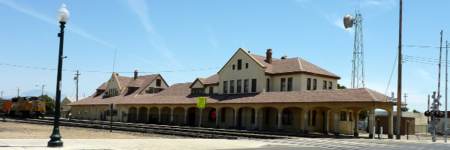Bakersfield CA: Difference between revisions
No edit summary |
No edit summary |
||
| Line 5: | Line 5: | ||
|municipality=City | |municipality=City | ||
|established=January 1, 1873 | |established=January 1, 1873 | ||
|area=151.28 | |area=151.28 sq mi | ||
|elevation=404 ft | |elevation=404 ft | ||
|population=403455 | |population=403455 | ||
Revision as of 17:01, June 15, 2024
- Members
Bakersfield is a city in and the county seat of Kern County, California, United States. The city covers about 151 sq mi near the southern end of the San Joaquin Valley, which is located in the Central Valley region.
Activities

|
Solar-Powered Truck Charging Depot | |
| WattEV's Bakersfield electric truck charging depot, spanning 119 acres, integrates a solar-powered microgrid with rapid megawatt charging, reducing truck dwell time to under 30 minutes. | ||
Details
Bakersfield's population as of the 2020 Census was 403,455, making it the 48th-most populous city in the United States and the 9th-most populous in California. The Bakersfield–Delano Metropolitan Statistical Area, which includes all of Kern County, had a 2020 census population of 909,235, making it the 62nd largest metropolitan area in the United States.
Bakersfield is a significant hub for both agriculture and energy production. Kern County is California's most productive oil-producing county and the fourth most productive agricultural county (by value) in the United States. Industries in and around Bakersfield include natural gas and other energy extraction, mining, petroleum refining, distribution, food processing, and corporate regional offices. The city is the birthplace of the country music genre known as the Bakersfield sound.
History
Archaeological evidence indicates the presence of Native American settlements dating back thousands of years. Upon Spanish arrival, present-day Bakersfield was inhabited by the Yowlumne, a Yokuts people. Yowlumne accounts indicate that the village of Woilu was situated in the bounds of the present city.
The Yokuts of the region lived in lodges along the branches of the Kern River delta and hunted antelope, tule elk, deer, bear, fish, and game birds.
In 1776, Spanish missionary Francisco Garcés became the first European to explore the area. Recording his May 1 arrival to a Yokuts village along the Kern River, immediately northeast of present Bakersfield, Garcés wrote,
The people of the rancheria had a great feast over my arrival, and having regaled me well I reciprocated to them all with tobacco and glass beads, congratulating myself on seeing the people so affable and affectionate.
Given the remoteness and inaccessibility of the region, the Yokuts remained largely isolated from further contact until after the Mexican War of Independence, when Mexican settlers began to migrate to the area. Following the discovery of gold in California in 1848, settlers flooded into the San Joaquin Valley. In 1851, gold was discovered along the Kern River in the southern Sierra Nevada, and in 1865, oil was discovered in the valley. The Bakersfield area, once a tule reed-covered marshland, was first known as Kern Island to the handful of pioneers, who built log cabins there in 1860. The area was subject to periodic flooding from the Kern River, which occupied what is now the downtown area, and experienced outbreaks of malaria.
Bakersfield is the fifth-largest majority-Hispanic city in the United States, with 53% of its population being Hispanic in 2020.

